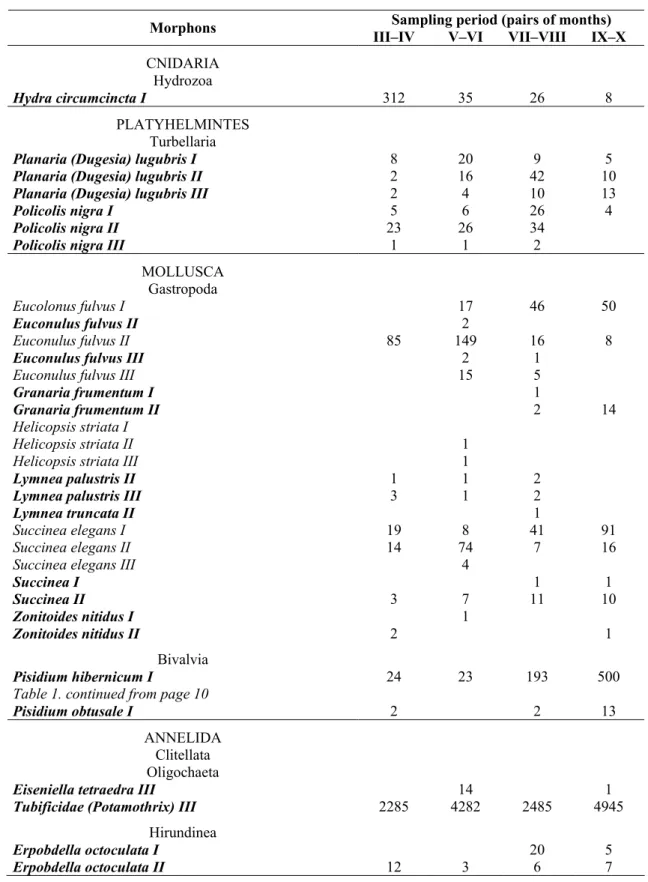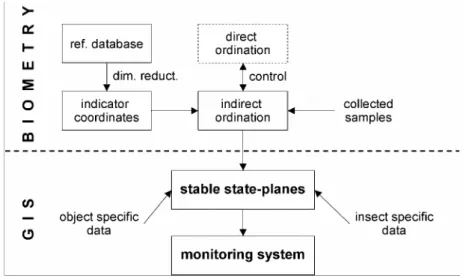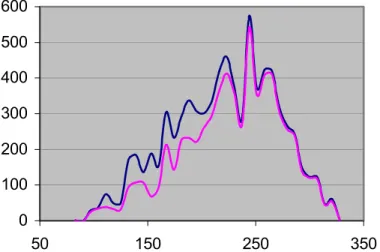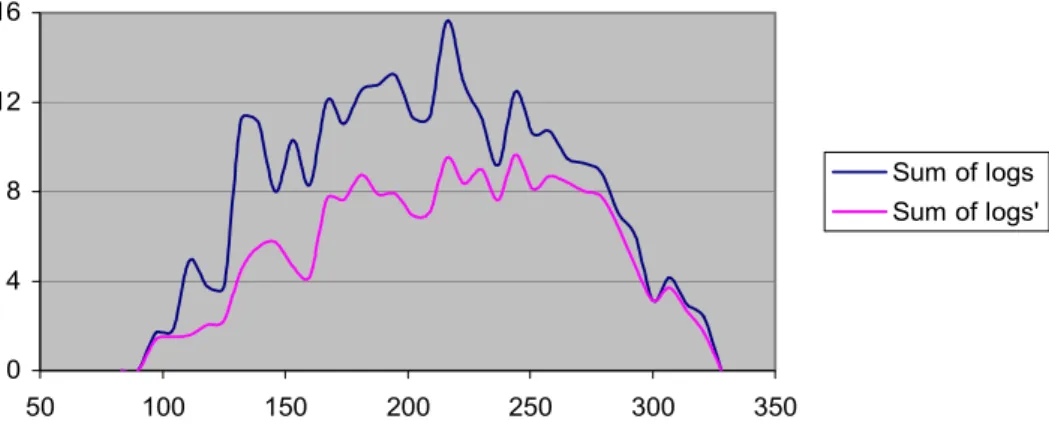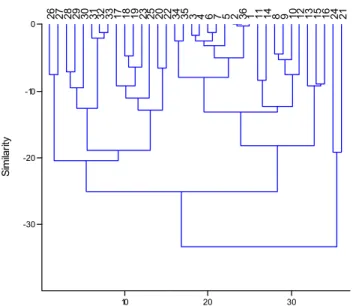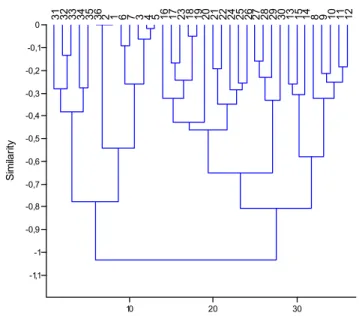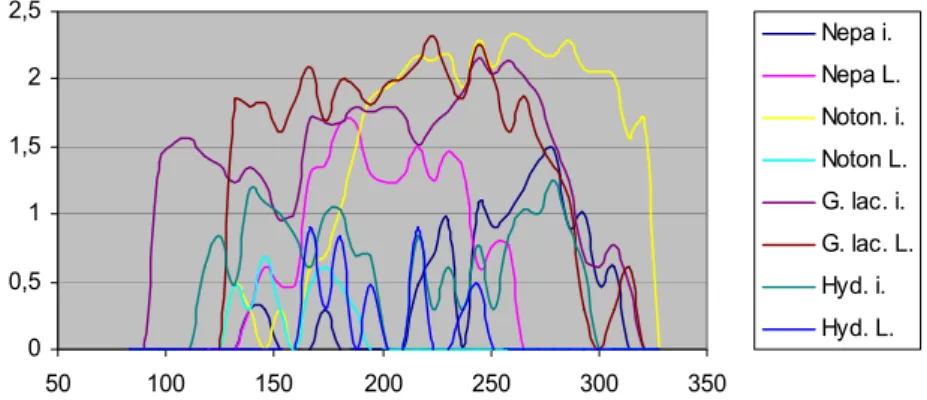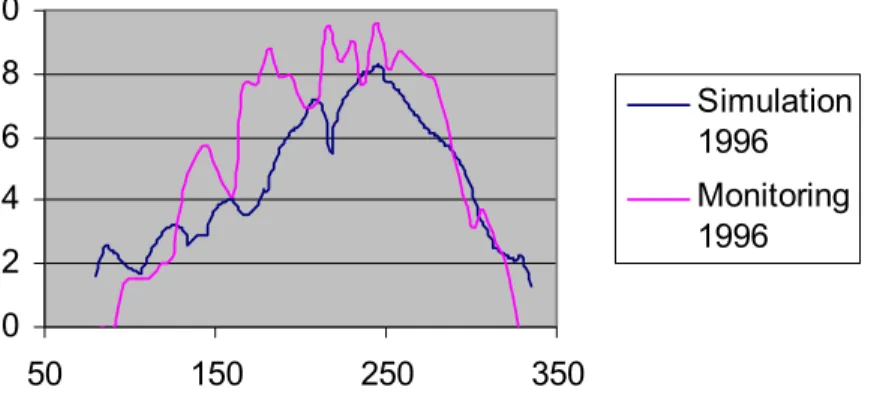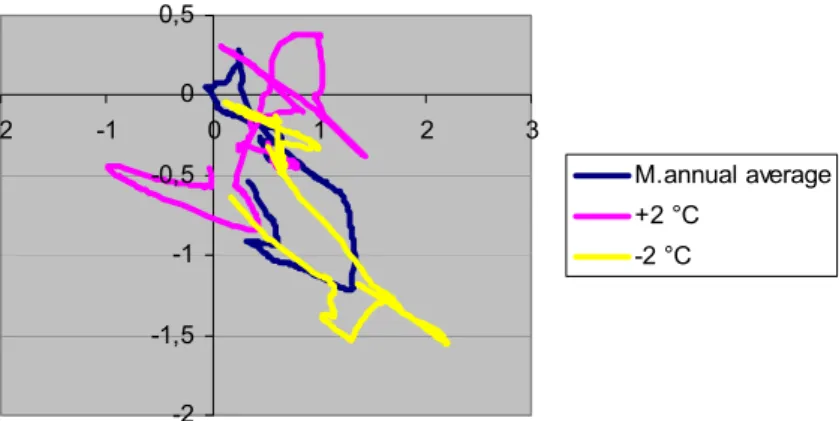CLIMATE CHANGE RESEARCH
A METHODICAL CASE-STUDY — MONITORING AND SIMULATION BASED ON AN AQUATIC INSECT COMMUNITY
L.HUFNAGEL* –M.GAÁL
*e-mail: levente.hufnagel@uni-corvinus.hu
Department of Mathematics and Informatics, Corvinus University of Budapest, H-1118 Budapest, Villányi út 29–43, Hungary
Phone: +36-1-482-6181, fax: +36-1-466-9273
*Corresponding author
(Received 1st Jan 2004, accepted 28th June 2005)
Abstract. Our aim was to approach an important and well-investigable phenomenon – connected to a relat- ively simple but real field situation – in such a way, that the results of field observations could be directly comparable with the predictions of a simulation model-system which uses a simple mathematical apparatus and to simultaneously gain such a hypothesis-system, which creates the theoretical opportunity for a later experimental series of studies. As a phenomenon of the study, we chose the seasonal coenological changes of aquatic and semiaquatic Heteroptera community. Based on the observed data, we developed such an ecological model-system, which is suitable for generating realistic patterns highly resembling to the observed temporal patterns, and by the help of which predictions can be given to alternative situations of climatic circumstances not experienced before (e.g. climate changes), and furthermore; which can simulate experimental circumstances. The stable coenological state-plane, which was constructed based on the principle of indirect ordination is suitable for unified handling of data series of monitoring and simulation, and also fits for their comparison. On the state-plane, such deviations of empirical and model-generated data can be observed and analysed, which could otherwise remain hidden.
Keywords: state-planes, NMDS, ordination, seasonality, Heteroptera, similarity patterns
Introduction and objectives
Discovering the structure and operational mechanisms of aquatic communities and exploring the basic pattern generating processes is a scientific task standing in the front- line of ecological research; it has an extraordinary significance both from the aspect of basic and applied research. Thorough knowledge of the temporary state and the changes occurring in our environment is inevitable to prudently coordinate our society-level activities. Examining the state of living communities which the Biosphere contains, trac- ing the changes in their state (monitoring), evaluating data structures and researching the affecting factors standing behind ecological patterns can be mentioned among the most important objectives from the aspect of the long-term interests of human society [105].
Concerning the methodical and methodological trends of ecological research, three main approaches can be distinguished.
Field ecologists who start from the observation of real natural processes are striving during their examinations to cause the less disturbation to these processes [94, 115, 159, 176]. Their task is the prejudication-free description of synbiological patterns and in the possession of these precise descriptions (data series and tables) they try to explore the affecting factors (or to be more precise: their background patterns) generating the observed patterns. To achieve this, they generally apply the multivariate data-structure
by international comparison – to the works of Juhász-Nagy [88, 89, 90] and his followers.
Another school of ecological research does not concentrate on the complex description of natural processes, but stands a hypothesis connected to a selected part-phenomenon or a hypothesis-system consisting of some alternative hypotheses to the focus. The point of these works is to test the differentiating predictions of hypotheses – often during firmly controlled, manipulative experiments. In the evaluation of these experiments, the traditional possibilities of trial statistics and variance analysis are exploited [45, 139].
Often cited classics of „anglo-saxon ecology” followed this way in many cases [147].
The third main trend is represented by modelling (theoretical) ecologists who – in the possession of well-described basic biological phenomena and with the application of the most possible hypotheses – construct a very precise mathematical description (model) of the simplest theory concerning the observed phenomenon. The point of this methodology can be described as a logic cycle, which consists of testing (confronting the model with case studies) and developing (upgrading and re-constructing) the model. By applying this methodology, more and more realistic theory of the observed phenomenon can be gained, but in the initial stage of the work only a fragment of the available knowledge is used.
The leading studies and handbooks of exact theoretical ecology use ecological model- systems as main guidelines, the results of the other two approaches mentioned above are used in many cases only as illustrations. However, the constructed models available these days are quite far from the observed results of field ecologists [87].
All three approaches detailed above have some obvious advantages and disadvantages.
Reliable, prudently checked and justified knowledge can be obtained most easily by evaluating experimental situations. But very often the criteria of prudent checking either excessively narrows the valid circle of the statement or limits the complexity of the phenomena which can be examined this way. By the help of this methodology, such results can be obtained relatively easily which are justified professionally at quite high quality, however these are of low heuristic power and far from practical availability.
Thus, correct observation and detailed description is inevitable for studying complex – and from pratical aspect potentially important – phenomena, since it is impossible to draw realistic hypotheses without reliable basic data. Problem is that field ecology studies which try to examine communities existing among or close to natural circumstances in complex approach, are forced to stay at gaining basic data or – at most – exploring simple correlations, because during reasoning such complicated hypotheses should be drawn, by which testing would prove to be an absolutely hopeless effort. By reasonal examination of complex phenomena, the description of hypotheses in simulation models can not be avoided, since without them we wouldn’t be able to predictively differentiate between alternative explanations. Another advantage of simulation technique is that it reflects those interpretational errors, which can be disregarded even at the stage of unifying those part-theories which are separately justified or at the stage of statistical evaluation.
Ecology, as a separate field of science was named by Haeckel in 1866, but at that time he meant to a some extent different discipline under this name: a physiological field of studies which examines the connection of living organisms and their environment – source: [109]. However, it has to be admitted, that a bit later he also formed a more sophisticated opinion:
„By ecology we mean the body of knowledge concerning the economy of nature – the investigation of the total relations of the animal both to its inorganic and to its organic
the study of all those complex interrelations referred to by Darwin as the conditions of the struggle for existence” (Ernst Haeckel 1870, source: [1]).
Basics of supraindividual biology – which in todays professional term is now regarded as „ecology” – were laid down in the works of Clements [34, 35], Voltera [199, 200], Lotka [104], Elton [42], Gause [52], Lindeman [101, 102], and Allee [1, 2, 3], in the first half of the 20th century. In the early works, results of the three methodical ways detailed above were present supporting each other, and in unity. However, the three roots of the different methodical schools existed even at the dawn of ecology, so none of them can be considered as older or newer than the others.
According to the corporal point of view of the Ecological Committee of the Hungarian Academy of Science, ecology:
„has the task to research those limiting (…) phenomena and prosesses (…), which directly control the behaviour and spatial-temporal quantitative distribution of populations and their communities.” [5].
So the corporal point of view leaves the methodical problem open. Up to now, this methodical specialization has grown to such an extent, that the representatives of the diff- erent ecological schools often can not even comprehend each others works and they group in separate organisations, publish in different papers and use substantially different terms.
Specialist field researchers often have the opinion that taxonomical and faunistical exploration of nearly natural communities (but even agro-ecosystems and other mono- cultures as well) is at such a low level, that forming of operational hypotheses or models makes completely no sense. According to them, many decades have to pass until data collecting and description can be exceeded. Followers of the experimental methodology think however, that serious scientific research can be conducted only in the case if there is a clear “professional hypothesis” before the start of the work. If this is the only way, we should examine even dramatically simplified experimental situations, but we have to strive to gain scientifically proven knowledge. Many modelling ecologists (“strategic modellists” or “theoretical ecologists”) tries to get a grasp on basic phenomena and to study the theoretical possibilities. According to them, the development of the method- ology of ecological modelling is the most important step. “Tactical modellists” or “app- lied ecologists” concentrate exclusively on the prognostical usefulness of the model, and they do not even care about comprehensibility (biological interpretability of mathematical expressions) of the models.
Although the above-mentioned theories are seemingly fundamentally contradictory to each other, each of them is logical in itself, and in its right place acceptable.
During our research which led to this current work, our aim was to try to approach an important and well-studiable phenomenon – connected to a relatively simple but real field situation – in such a way, that the results of field observations could be directly compared with the predictions of a simulational model-system which uses a simple mathematical apparatus and, simultaneously gaining such a hypothesis-system, which creates the theoretical opportunity for a later experimental series of studies.
Our opinion is that it is worth dealing with the approach of the three methodical schools during real case studies – even if the initial research results are obviously less detailed from the point of describing, less developed from the aspect of modelling and less controlled compared to experimental methodology – since working out of a unified methodical framework can be expected only from series of real case studies.
stable water level of the Szilas stream at Budapest. This part of the stream can be found right under Lake Naplás, its basin is dug and grassed, and the surrounding transect of the basin has nearly natural flora. As a phenomenon of the study, we chose the seasonal coenological changes of aquatic and semiaquatic community of Heteroptera species.
During pre-examinations the Szilas stream and its side-waters were from their source to destination thoroughly surveyed and preliminary examinations have been made. In the text of the current work, the expression “Szilas stream” means exclusively the section marked for detailed studies and its state between 1991 and 2002.
For a phenomenon to study, we chose the seasonal coenological changes in the state of the aquatic and semiaquatic Heteroptera community.
Direct objectives of our work in accordance with the above-mentioned facts can be summarized as follows.
1. Working out of such a methodical case study, which synthetises, tests and develops the field- and simulational methods suitable for investigating the seasonal changes of aquatic communities.
2. Description of the seasonal changes of the Heteroptera community and exploration of the main principles of the process on the observed section of Szilas stream.
3. Developing such an ecological model-system, which is suitable for generating realistic patterns highly resembling to the observed temporal patterns, and by the help of which predictions can be given to alternative situations of climatic circumstances not experienced before (e. g. climatic changes), and furthermore which can simulate experimental circumstances.
Review of literature
The research of aquatic and semiaquatic Heteroptera has a significant history in Hungary from the beginning of the XX. century to our days but the publications are mainly taxonomic and faunistical issues. We know very little about these species from ecological and zoocoenological aspects, however recently complex ecosystem observ- ations took place in some of their biotops [189]. These before-mentioned facts even in themselves would underline the importance of such examinations. In addition, some publications mention that in certain aquatic habitats these animals might have out- standing ecological significance simply due to their quantitative proportions [120]. But maybe even more important is the fact that the majority of them are predators, so they are near to the end of the foodchain of aquatic communities [9]. Such living organisms – based on numerous experiences – could be relatively sensitive for even tiny or (for us) hidden changes in their environment. These attributes render them especially suitable for (following the principle of bio-indication) tracing the changes in their environment and to gather important information on their habitats [72, 73]. Besides, certain aquatic Heteroptera species bear huge economical significance being fish pests and/or fish feed.
Moreover, the possible role of some semiaquatic species in public health [117] and plant protection [158] can be also interesting.
One of the most important pattern-generating factor of the moderate climate nearly natural ecosystems is seasonality and the seasonal dynamism of the community struc- ture which follows it. Based on database findings of the National Light-Trap Network for Plant Protection and Forestry seasonal dynamism hides the pattern generating role of
same year are much greater than that can be generally perceived on the same aspects of different years on different Hungarian habitats. Results of Schmera [167, 168] also prove this, who examined the flying activity patterns of a selected Trichoptera species and couldn’t find great differences between the sampling spots. Patterns were syn- chronized but significant differences could be observed between months. Work of Ayre
& Lamb [7] support the theory of lesser significance of annuality.
In aquatic ecosystems, the connection of seasonality and eutrophisation has been examined mainly from system-ecological aspect [57].
Seasonal dynamic examinations of Heteroptera communities in aquatic habitats Regrettably, both domestic and international literature lack works which analysed the seasonal dynamic patterns of coenologic state changes of aquatic Heteroptera commun- ities. However, basic data bearing information on seasonal appearance patterns of aquatic Heteroptera or dealing with seasonal part-phenomena or seasonal characteristics of certain species are available. The most detailed general ecological summaries can be found in the works of Savage [162, 163, 164, 166] and Møller-Andersen [121] for the Western- European species. By studying these works, a picture from the main disciplines generally characteristic to Gerro- and Nepomorphans can be gained. There can be found basic data suitable for coenological and seasonal dynamic analysis in the work of Green [53] from the macroinvertebrata (even Heteroptera) fauna of three Great-Britain ponds, however, the paper does not deal with the interpretation of patterns.
There are many publications dealing with different bioindicational issues, thus in- directly pointing on factors and phenomena influencing seasonal patterns. There are also known for a long time such kind of efforts, which try to describe individual habitats by aquatic and semiaquatic Heteroptera communities. Among others, Fairbairn [46], Spence [177, 178, 179], Nummelin & al. [127], Vepsäläinen & Nummelin [198], Oscarson [131]
and Vásárhelyi [191] also deals with habitat selection. Connecions between habitat, population structure and seasonality are examined in the [202] work of Zimmermann through the life-cycle of the semiaquatic Heteroptera named Mesovelia furcata which also lives in Hungary. Similar examinations has been conducted by Brönmark & al. [29] on the Velia species in Swedish streams. Macan [106] indicated correlation among species composition of the aquatic Heteroptera, certain chemical parameters of lakes and the quantity of coastal vegetation. Savage & Pratt [165] in an early study couldn’t find any correlation among certain chemical parameters and aquatic Heteroptera communities.
Later, however, significant influence of water conductivity has been pointed out [161, 162]. The pH of the water has also a determining effect on the species composition of the aquatic Heteroptera communities [44]. Effects of pH and temperature are evaluated in the 1996 paper of Blacchi & al. based on faunistical data series on aquatic and semiaquatic Heteroptera living in Italy. Macan [107] found tight correlation between the quantity of organic matter accumulating in lakes and the aquatic Heteroptera species and communi- ties. Bröring & Niedringhaus [30, 31] pointed out correlation between the type of the examined lakes and the Heteroptera species which can be found in them. In recent times multivariate statistical methods were also applied in the exploration of the structure of aquatic and semiaquatic Heteroptera communities [48, 49, 50, 70, 72, 73]. These groups were found not to be quite suitable for water characteization by Eyre & Foster [44].
out the saprobiological indexes of Central European Corixidae species. These are held valuable by Savage [164] for the application for water qualification purposes. Correlation of seasonal phenomena and hidrobiological features are dealt with in the works of Pandit
& al. [135, 136, 137] concerning Indian currents and also at DuBois & Rackouski [41] in connection with North American still-water habitats.
Numerous papers deal with the life-cycles and phenological phases of certain, indi- vidual species based on both field and laboratory examinations, however, most of them primarily concentrate on species which aren’t distributed in Central Europe [33, 39, 85, 86, 111, 125, 123, 130, 160]. In the work of López & al. [103], phenology, larval stages, certain quantitative morphological characteristcs and some water-chemical parameters of the collection sites of a Sigara species prevalent in the Iberian Peninsula have been evalu- ated. The study of Pajunen & Jansson [134] measures seasonal changes of sex ratio concerning still-water Corixidae, and this paper also serves as a useful methodological work for modelling. Packauskas & McPherson [133], McPherson [114], McPherson & al.
[112, 113] and Kaitala [92] conducted thorough experimental, controlled in vitro life- cycle studies.
There have been also published important studies in recent years in connection with ecophysiological mechanisms which are in the background of seasonal-dynamic patterns [22, 27, 95]. Results of this kind could prove useful later by interpreting processes or developing models.
Quite interesting, that numerous papers deal with the seasonal aspects of wing poly- morphism [4, 54, 170, 179, 201, 124]. Field data show that this characteristic should be considered by fine-tuning of models. The amazingly thorough study of Vepsäläinen [197] deals with seasonality, wing polymorphism and correlations between pigmenta- tion and habitat, which has been conducted on Gerris species during his short visit in Hungary.
There isn’t any summarising work for Hungarian species yet. Comments based on collecting experiences can be found in the works of Soós [175] and Benedek [21]. The most detailed and summarized work about Nepomorphs is undoubtedly the work of Bakonyi [9] – this study also includes coenological, phenological and population gene- tic chapters – however it does not deal with semiaquatic Heteroptera. Faunistical notes from the area of Hungary casually include data applied for different dates of colletction, but these can be considered generally sporadic. Data from the most thoroughly explored areas published by different authors are generally simple species lists [10, 11, 12, 13, 14, 23, 24, 25, 36, 47, 58, 59, 62, 64, 74, 173, 183, 186, 190, 192, 194]. This is because explorative faunistical studies have generally been conducted for completely different purposes, and even if there some other data emerged, there haven’t been published directly. Fortunately some counter-examples can be also found [119, 120].
On the present level of our knowledge and available data, the „museum method”
worked out by Soós [174] and further developed by Vásárhelyi [187] provides reliable information on phenological characteristics of individual domestic species. With this method, characteristics of aquatic and semiaquatic Heteroptera species have been described by Benedek [19], Benedek & Jászai [20] and Bakonyi [9]. Based on our own field observations, predictions of the „museum method” coincide quite well – in some cases highly above the expected level – with data from detailed quantitative measure- ments.
insects and insect communities are also detailed in some of our other publications and by working up models, the experiences of these works have been also utilized: [75, 78, 129, 132, 150, 193]. We usually only cited these basic data which were used for evaluating seasonal-dynamic patterns and were published generally in faunistical notes and in our papers dealing with pattern evaluation. We reported about Heteroptera in our following data-announcing papers: [37, 38, 62, 63, 64, 65, 66, 67, 74, 183, 184]. Other publication related to Heteroptera: [76]. Basic faunistical data on other insects used for seasonal analyses are included in the following papers: [25, 40, 153, 154, 155, 156, 157].
Materials and methods
The examined section of the Szilas stream as a habitat
A most detailed definition of the characteristic features of a habitat selected for the purpose of an ecological case-study is crucial to create a firm base for comparisons with other observations carried out (maybe later) by others, on other habitats. Regrettably, exploration of domestic small water currents is at very low level (on 90% of the currents not any kind of meritable examinations have taken place until recently). Thus, in this part we could rely only on the results of the pre-examinations and some literature sources.
A decisive proportion of our field studies published in this paper has been carried out between 1991 and 2002 on a (Danube-side) section of Szilas stream, which lies next to the Naplás Lake of Budapest (former Szilas stream reservoir). The Szilas stream is a left-side tributary stream of Danube, which flows through the Pest Alluvial Plain. The area can be found on the northeastern part of Budapest, at the eastern border of the XVI.
District. The relatively stable hydrological properties of the section in question are guaranteed by Naplás Lake (or the leaking of its dam). The work has been started with the practical environment protection examination series for preserving natural values of Naplás Lake and its surroundings. As a result of the series of examinations, the most valuable parts of the area became protected. The geomorphological characteristics of the landscape are determined mainly by the 400–500 m wide alluvium of the stream and the V. Danube terrace which is more gently sloping on the Northern and steeper on the Southern side and consist mainly from grave and sand [91, 140, 141, 169]. The Szilas stream appeared in the Pleistocene era. The flow direction of the stream was shaped to gain its present characteristics during the effects of Middle-Würm movements. At the beginning of the Holocene era, the Szilas stream formed two narow terraces, huminite molding slime being the main material of its alluvium [180].
From climatic aspect, the area can be considered as moderately warm and dry, with a slightly less than 2000 sunlight hours (1800 hours in summer and 180 in the winter).
Annual average temperature is 10.0–10.2 °C, length of frost-free period varies between 188 and 219 days. Historical average of maximum temperature varies between 34.0–34.2
°C, minimum temperature betwen -14.5–16.5 °C. Daily average temperature between April 10th and October 19th exceeds +10 °C, this means 190–192 days annually. Annual sum of precipitation is approximately 550–600 mm, 310–340 mm in the vegetation period. 30–33 snow-covered days are presumable, average maximum snow thickness reaches 20 cm. Aridity index moves between 1.17 and 1.28. Most prevalent wind direc- tion is NW, average wind speed is between 2.5–3 m/s [110].
On the section in present study, average width of the stream is between 150–250 cm, average depth in the current line is 8–35 cm, with a current speed of 0.01–0.4 m/s in the
30–100%, shading of the foliage above the water-course under 1%. By our own measure- ments, pH of the water is between 7.8–8.3, conductivity 0.79–1.90 mS/cm, chemical oxygen demand (KOIMn) 3.2–15.0 mg O/dm3, level of dissolved oxygen 70–100%, algae count 0.3–3.5·106 (individual/dm3). We measured by coloritmetric rapid tests the nitrate concentration between 10–25 mg/dm3, nitrite 0.05–0.25 mg/dm3, phosphate 0.1–
0.6 mg/dm3. We couldn’t detect ammonia with rapid test. Further chemical and hydro- logical data were published in [74]. From hydrobiological aspect, the water can be con- sidered mesosaprobic, meso-eutrophic and mesohalobic.
From botanical aspect, the valley of Szilas stream lies on the border of two flora regions, Matricum and Eupannonicum. Vegetation and plant-coenological characteristics are described in the works of Borbás [28] and Rajkai [148, 149]. The vegetation of the immediate surroundings of the examined section has been described in detail by Stoll- mayer [180], vegetation of the water-course by Hufnagel & Stollmayer [74]. Vegetation of the examined section is mainly characterised by Sium latifolium L., Myosotis palustris (L) Nath. em. Rchb., Mentha longifolia (L) Nath., Mentha aquatica L., Juncus inflexus L., Scirpus sylvaticus L., and Carex acutiformis Ehrh.
The fish fauna of the section has been examined by T. Erős. According to his (hitherto unpublished) data, on a large proportion of the area, fish hardly can be found. Based on his thorough examinations, in the deeper parts of the course small numbers of crucian carp (Carassius carassius), spined loach (Cobitis elongatoides complex), roach (Rutilus rutilus), European chub (Leuciscus cephalus), black bullhead (Ameiurus melas), bleak (Alburnus alburnus), European perch (Perca fluviatilis), pumpkinseed (Lepomis gibbo- sus) and Chinese rasbora (Pseudorazbora parva) can be found.
According to the number of individuals, 89% of the fish belong to the omnivor, 5%
to insectivor-piscivor, 4% to insectivor-detritivor, 2% to insectivor feed biology group.
Most prevalent species is the crucian carp.
According to literature data [93, 180] in the vicinity of Lake Naplás, numerous amphibious species, like smooth newt (Triturus vulgaris), crested newt (T. cristatus), fire- bellied toad (Bombina bombina), common tree frog (Hyla arborea), spadefoot toad (Pelobates fuscus), common and green toad (Bufo bufo, B. viridis), agile frog (Rana dalmatina), European common frog (Rana temporaria) and edible frog species group (Rana esculenta complex) can be found. This is the first published flatland occurrence of European common frog. Based on our own experiences, moorfrog (Rana arvalis) and common toad seem to be the most common. We could not observe any newts, European common frogs and common tree frogs, however, We did not conducted surveys directly on amphibious species. As for reptiles, we observed grass snake (Natrix natrix) and European pond turtle (Emys orbicularis) on one or two occasions. Stollmayer & al. [180]
gives a thorough overview about the bird fauna of the territory, however, we could not observe significant presence of water fowls on the examined section of the stream.
Between 1991 and 2002 we continuously collected data and observations about the invertebrate fauna of the examined section of stream. The most profound general zoologic exploration took place during the series of examinations in 2002. At that time, from 15th March to 27th October (beside the ordinary Heteroptera sampling) we also conducted regular – fortnightly done – zoocoenological sampling, which consisted of identical methods during the full length of the examination period, namely silt sampling, water netting, surface netting, grass-netting of above-surface vegetation and plankton-net
avoided the bench line, during grass-netting just plants leaning over the riverbed from a 10 cm wide zone of the coastal line could be incorporated. We considered the examina- tion of the vegetation stretching over the waterbed very important for four reasons. At first, because certain members of the semiaquatic predator guild (e.g. Hydrometra spp., semiaquatic wolf spiders etc.) and just hatched adults of aquatic insects are very often located here. Secondly, because one of the main kind of food of the Gerris species are
„land” insects accidentally fallen onto the water surface. Thirdly, because the hereby abiding net-spinning spiders are important predators of the insects flying out of the water (e.g. gnats, mayflies), and finally because the herbivore insects can exert a significant effect on the community by eating on aquatic plants.
A summarising overview on the main data of general, zoological exploration in year 2002 are shown in Table 1.
A summarising overview of the main data of the general zoological survey conduc- ted in the spring of 2002 can be seen in Table 1. Animals are classified into morphones because taxa in themselves are less explanatory from the aspect of seasonal dynamic patterns. It can be clearly seen from the table, that the different development stages or body size categories of the same taxon show fundamentally different coenological behaviour. To achieve a uniform structure, we followed the system of Papp [138] during higher taxonomical classification, and we took the work of Móczár [118] as a base for naming morphones (at levels below families) even when we used different works for identification. Samples from the water body are given conjugated in order to achieve briefer data and transparency, because the method of collection can be generally presumed from the name of the taxon (and body size category). Numerical data given in the table can be compared row-wise, since comparison between different rows can be informative only in case of identical body-size categories.
Methods of field monitoring
We have been studying the Heteroptera community of the Szilas stream since 1991.
In this study, the field data collected in 1996 are processed and evaluated. The seasonal dynamic patterns in the vegetation period (between March and November) with the greatest frequency were observed in 1994 (monthly), in 1996 (weekly) and in 2002 (fortnightly). We only collected qualitative data in 1991 and 1992. In 1993, 1995, 1998 and 1999 we sampled 3-4 times in the vegetation period. From the years of 1997, 2000 and 2001 we do not have any data. We used a method, which was designed for qualitative purposes – however being rather semi-quantitative – to explore the seasonal- dynamic patterns. In the winter period we only conducted qualitative examinations.
Based on our data and observations it can be stated that in the period between 1991 and 2002 on the examined section of Szilas stream (under Lake Naplás) fundamental changes have not been occurred nor in the hydrological and vegetation characteristics, nor in the structure of the Heteroptera community.
For the purpose of our studies, we chose a 300 m long section of Szilas stream below the Naplás Lake. The peculiar section was chosen for its homogeneity from floral and hydrological aspects.
The coenological survey of Heteroptera consisted of the simultaneous application of two very different methods, namely a quantitative area-closing sampling and a roving hand-webbing collection.
category (I: below 5 mm, II: between 5–10 mm, III: above 10 mm) or in case of insects, from morphological state (larva, pupa, adult etc). Table contains data from aquatic samples (typed in bold) and data gained from grass-netting the above-surface vegetation (typed in normal characters).
Sampling period (pairs of months)
Morphons III–IV V–VI VII–VIII IX–X
CNIDARIA
Hydrozoa
Hydra circumcincta I 312 35 26 8
PLATYHELMINTES Turbellaria
Planaria (Dugesia) lugubris I 8 20 9 5
Planaria (Dugesia) lugubris II 2 16 42 10
Planaria (Dugesia) lugubris III 2 4 10 13
Policolis nigra I 5 6 26 4
Policolis nigra II 23 26 34
Policolis nigra III 1 1 2
MOLLUSCA
Gastropoda
Eucolonus fulvus I 17 46 50
Euconulus fulvus II 2
Euconulus fulvus II 85 149 16 8
Euconulus fulvus III 2 1
Euconulus fulvus III 15 5
Granaria frumentum I 1
Granaria frumentum II 2 14
Helicopsis striata I
Helicopsis striata II 1
Helicopsis striata III 1
Lymnea palustris II 1 1 2
Lymnea palustris III 3 1 2
Lymnea truncata II 1
Succinea elegans I 19 8 41 91
Succinea elegans II 14 74 7 16
Succinea elegans III 4
Succinea I 1 1
Succinea II 3 7 11 10
Zonitoides nitidus I 1
Zonitoides nitidus II 2 1
Bivalvia
Pisidium hibernicum I 24 23 193 500
Table 1. continued from page 10
Pisidium obtusale I 2 2 13
ANNELIDA
Clitellata
Oligochaeta
Eiseniella tetraedra III 14 1
Tubificidae (Potamothrix) III 2285 4282 2485 4945
Hirundinea
Erpobdella octoculata I 20 5
Erpobdella octoculata II 12 3 6 7
Hirundinea (continued)
Erpobdella octoculata III 12 23 22 24
Glossiphonia complanata II 1
Glossiphonia complanata III 1 1
ARTHROPODA
Arachnida
Araneae
Agriopidae I 2
Agriopidae I 1 5 7
Dictynidae: Dictyna arundinacea II 1
Lycosidae I 3 5 18 2
Lycosidae II 5 6
Lycosidae: Pardosa amentata I 1
Lycosidae: Pirata latinans I 6 1 6
Lycosidae: Pirata piraticus I 3 1 52 14
Lycosidae: Pirata piraticus II 2 6 1 24
Lycosidae: Pirata piraticus III 1
Pisauridae I 5 15 3
Pisauridae II 1 1 2 4
Salticidae II 1
Tetragnathidae (T. extensa) I 10 2 6 21
Tetragnathidae (T. extensa) II 7 15 2
Tetragnathidae (T. extensa) III 2
Tetragnathidae I 71 31 30 47
Tetragnathidae II 2 27 26 6
Theridae I 1
Theridae II 1
Thomisidae I 1
Thomisidae I 21 3 12 13
Acari
Hydracarina I 3 4 1 3
Ixodes ricinus I 3
Ixodeus ricinus I 1
Oribatida I 17 25 22 8
Malacostraca Edriophthalma
Asellus aquaticus I 26 6 1
Asellus aquaticus II 40 5 10 1
Gammarus roeseli I 1591 3977 5617 7536
Gammarus roeseli II 1473 6445 5073 6340
Gammarus roeseli III 525 2007 2000 2950
Oniscoidea I 1
Oniscoidea II 1 2 1
Maxillopoda
Copepoda
Acantocyclops (?) I 26 1
Acantocyclops robostus I 317 1769 1983 1862
Eucyclops I 28 133 34
Eudiaptomus I 14 330
Ostracoda
Heterocypris salina I 3 11 3
Limnocythere sanctipatricii I 28 37 536 26
Phyllopoda
Cladocera
Chydorus sphaericus I 4 384 7
Parainsecta
Collembola
Entomobrya quinquelineata I 3 2 3
Lepidocyrtus cyaneus I 2 10 7
Lepidocyrtus paradoxus I 2 4 3
Orchesella cincta I 1
Podura aquatica I 28 28 10 55
Sminthurides aquaticus I 2
Insecta
Ephemeroptera
Baetis I larva 331 216 786 87
Baetis II larva 131 227 1622 269
Baetis II adult 2
Baetis III larva 75
Cloeon larva 18 4
Prosopistoma I subimago 1
III-IV. V-VI VII-VIII IX-X.
Odonata
Aeschnidae:Aeschna affinis III larva 2 1
Agrionidae: Ischnura elegans III adult 2
Agrionidae: Ischnura pumilio III larva 3 6
Agrionidae: Ischnura pumilo I larva 10 1
Agrionidae: Ischnura pumilo II larva 1 1 99 85
Agrionidae: Ischnura pumilo III larva 12 23 168
Agrionidae: Coenagrion puella III adult 1
Agrionidae: Ischnura elegans III larva 2 2
Agrionidae: Platycnemis pennipes I larva 77
Agrionidae: Platycnemis pennipes II larva 18 3
Agrionidae: Platycnemis pennipes III larva 3 2 7
Agrionidae: Platycnemis pennipes III larva 1
Agrionidae: Pyrrhosma nymphula III adult 1
Calopterigidae: Calopteryx splendels III adult 1
Calopterigidae: Calopteryx splendens II larva 1
Calopterigidae: Calopteryx splendens III larva 4 1
Libellulidae: Libellula fulva II larva 2
Libellulidae: Libellula quadrimaculata I larva 1 1
Libellulidae: Libellula quadrimaculata II larva 1 1
Libellulidae: Libellula quadrimaculata III larva 2 2 2 5
Libellulidae: Orthetrum brunneum II larva 2
Libellulidae: Orthetrum brunneum III larva 1
Libellulidae: Orthetrum coerulescens III larva 6 2
Libellulidae: Orthetrum coerulescens III larva 1
Plecoptera
Nemouridae: Nemoura cinerea II adult 108
Nemouridae: Nemoura II larva 258
Ensifera
Conocephalidae: Conocephalus fuscus IIIadult 18
Ephippigeridae: Ephippigera ephippiger IIIadult 3
Caelifera
Acrididae III adult 3
Acrididae: Chorthippus parallelus III adult 18
Thysanoptera
Bolothrips cingulatus I adult 12 2
Limothrips angulicornis I adult 3
Thrips phsapus I adult 2
Thysanoptera I adult 4 1
Heteroptera
Anthocoridae: Orius laticollis I adult 1 1
Corixidae: Hesperocorixa linnaei I larva 1
Corixidae: Hesperocorixa linnaei I adult 1
Corixidae: Micronecta meridionalis I larva 5 7 2
Corixidae: Micronecta meridionalis I adult 2
Corixidae: Sigara lateralis I adult 2
Corixidae: Sigara striata I adult 1
Gerridae: Aquarius paludum III adult 1 1 2 1
Gerridae: Gerris argentatus I adult 3
Gerridae: Gerris asper II adult 1
Gerridae: Gerris lacustris II adult 66 87 346 254
Gerridae: Gerris lacustris larva 156 784 352
Gerridae: Gerris odontogaster II adult 1 2
Gerridae: Gerris odontogaster larva 1
Gerridae: Gerris thoracicus adult 2 4 5
Hydrometridae: Hydrometra stagnorum II larva 2 7
Hydrometridae: Hydrometra stagnorum III adult 2 12 13 5
Lygaeidae: Cymus glandicolor I adult 1
Lygaeidae: Cymus melanocephalus I adult 1
Lygaeidae: Raglius confusus I adult 1
Miridae: Adelphocoris lineolatus I adult 2
Miridae: Adelphocoris seticornis I adult 1
Miridae: Polymerus holosericeus I adult 2
Miridae: Stenodema calcarata I adult 2
Nabidae: Nabis ferus I adult 2 1
Nepidae: Nepa cinerea II larva 27 62 1
Nepidae: Nepa cinerea III adult 5 9
Notonectidae: Notonecta glauca II adult 3 18 48
Notonectidae: Notonecta glauca II larva 7 7
Pleidae: Plea minutissima I adult 4
Saldidae: Saldula opacula I adult 1
Scutelleridae: Eurygaster maura II adult 2
Tingidae: Agramma confusum I adult 1
Tingidae: Dictyla hamuli I adult 1
Veliidae: Microvelia reticulata I adult 2
Auchenorrhyncha
Cercopidae, Lepyronia II adult 1
Cercopidae, Philaenus spumarius I adult 1
Cercopidae, Philaenus spumarius II adult 1
Cercopidae: Aphrophora alni II adult 1
Cicadellidae : Cicadella II adult 1 2 3
Cicadellidae : Cicadula sp II adult 1 4
Cicadellidae I adult 6 19 37 60
Cicadellidae II adult 8 22 12
Cicadellidae, Edwardsiana rosae I adult 1
Cicadellidae, Eupteryx urticae II adult 2
Cicadinea I larva 5 4 2
Delphacidae I adult 4 8 37
Auchenorrhyncha (continued)
Delphacidae II adult 11 5 1
Delphacidae: Calligypona sp I adult 1
Delphacidae, Dicranotropis II adult 1
Delphacidae, Kelisia guttala I adult 6
Issidae I adult 2
Sternorrhyncha
Aphidinea I *A* adult 9 17 60
Aphidinea I *B* adult 3 27
Aphidinea I adult 16 30 139
Psyllinea I (Aphalara calthae) adult 1
Coleoptera
Anobiidae I adult 1
Anthicidae I adult 1
Anthribidae I adult 1 7 1
Bruchidae I adult 4
Byrrhidae I adult 1
Cantharidae I adult 2
Carabidae I adult 1
Carabidae II adult 1
Cerambicidae I adult 1
Cerambicidae III adult 1
Cerambycidae I adult 7
Cerambycidae II adult 2
Cerambycidae III adult 1
Chrysomelidae, Donacia semicuprea I adult 3 16 2 3
Chrysomelidae I adult 8 7
Chrysomelidae II adult 173 2 2
Coccinellidae I adult 1 8
Coccinellidae I adult 1 8 2
Coccinellidae II adult 1
Coccinellidae II adult 2
Curculionidae I adult 3 2 4
Curculionidae I adult 8 2 10 2
Curculionidae II adult 2
Curculionidae II adult 4 8
Curculionidae III adult 1
Drilidae I adult 1
Dytiscidae I adult 1 1
Dytiscidae I adult 3 1
Dytiscidae III adult 1 4
Dytiscidae, III larva 1 22 15
Gyrinidae II adult 5 4
Haliplidae I adult 1 6 2
Helophoridae I adult 2 6 3 4
Helophoridae I larva 7
Hydrophilidae I adult 6 11 114 13
Hydrophilidae II adult 1 1
Hydrophilidae III adult 1
Hydrophilidae/+Helophoridae/ I adult 6 2 6
Lampyridae II adult 1
Lampyridae III adult 1
Lathridiidae I adult 1
Malachiidae II adult 1 1
Coleoptera (continued)
Mordellidae I adult 1
Mordellidae I adult 1
Mordellidae II adult 2
Mycetophagidae I adult 2
Oedemeridae II adult 1
Scarabaeidae I adult 1 3 1
Scolytidae I adult 1
Spercheidae I adult 3
Staphylinidae I adult 2 3 2
Staphylinidae I adult 1 2 1
Megaloptera
Syalidae: Sialis fuliginosa III, adult 2
Syalidae: Sialis flavilatera I larva 1
Syalidae: Sialis flavilatera III adult 1
Hymenoptera
Agriotypidae II adult 1
Andreidae III adult 1
Aphidiidae I adult 1 2
Apidae III adult 1
Apoidae III adult 1
Aulacidae I adult 1
Belytidae I adult 1
Ceraphronidae I adult 1
Eulophidae I adult 1
Formicidae I adult 37 50 10
Formicidae I adult 7 43 52 3
Formicidae II adult 1 2
Formicidae II adult 2
Gasteruptonidae II adult 2
Hybryzonidae I adult 1
Ichneumonidae I adult 1
Ichneumonidae I adult 1 12 16
Ichneumonidae II adult 1 6 8 2
Ichneumonidae III adult 1
Maumaridae I adult 1
Orussidae I adult 1
Platygasteridae I adult 1
Scelionidae I adult 2
Tenthredinidae I larva 1 1
Tenthredinidae II adult 1
Tenthredinidae I adult 3
Tenthredinidae II adult 2 1 1
Tenthredinidae III adult 5
Trichoptera
Hydroptilidae: Ptilocolepus granulatus I larva 2
Leptoceridae: Athrispodes aterrimus larva 2
Limnephilidae: Grammotaulius III adult 3
Limnephilidae: Limnephilus II larva 340 115 10
Limnephilidae: Limnephilus III adult 8 12
Limnephilidae: Limnephilus III larva 667 423 111
Phryganeidae: Oligostomis III adult 9
Lepidoptera
Noctuidae I adult 1 2 1
Noctuidae II adult 4 2
Noctuidae III adult 1 3 1
Pyralidae I larva 1 1
Diptera
Agriotypidae II adult 2
Agromyzidae I adult 1 1
Annisopodidae II adult 3
Anthomyzidae I adult 2
Anthomyzidae I adult 4
Asilidae I adult 12
Asilidae I adult 1
Asilidae II adult 1
Asilidae I larva 2
Asteiidae I adult 1
Camillidae I adult 4 5 11 1
Cecidomyiidae I adult 1 1 2
Cecidomyiidae I adult 6 1
Ceratopogonidae I adult 2 23 25
Ceratopogonidae II adult 2
Ceratopogonidae I larva 47 33 4 25
Ceratopogonidae II larva 9
Chironomidae (a) I adult 5 2 3 25
Chironomidae (a) I larva 243 1144 3464 1117
Chironomidae (a) I pupa 11 60 67
Chironomidae (b) II larva 55 43 130 116
Chironomidae I adult 14 3 20 151
Chloropidae I adult 68 19 173 22
Choloropidae I adult 1 10 9
Conopidae III adult 2
Culicidae I adult 1 2 9
Culicidae II adult 2
Culicidae II adult 1 1
Culicidae I larva 33 136 6
Culicidae II larva 1 10 87 4
Culicidae II pupa 3 10 6
Curtonotidae I adult 1
Dixidae II adult 2
Dixidae I adult 1
Dixidae I larva 2 4
Dolichopodidae I adult 3 1
Dolichopodidae II adult 1
Dolichopodidae II larva 2 4
Drosophilidae I adult 1 2
Dryomyzidae II adult 1
Empididae I larva 2 6
Empididae II larva 4 2
Empididae II adult 3 2
Empididae III adult 1
Empididae III adult 3
Ephydridae I adult 55
Ephydridae I larva 6
Ephydridae I adult 10 17 10
Helomyzidae I adult 1 1
Diptera (continued)
Helomyzidae II adult 7 2
Lauxaniidae II adult 16 1 9
Limnoiidae II adult 4 4 4 1
Limonidae I adult 2
Limonidae II adult 1
Lonchopteridae II adult 7 5 8 5
Megamerinidae II adult 5
Milichiidae II adult 8 1 5
Muscidae I adult 6
Muscidae I pupa 2
Musicidae I adult 2
Musicidae II adult 1 14 5
Mycetophilidae I adult 9
Odiniidae I adult 5
Opomyzidae I adult 4 1
Otididae II adult 1
Pallopteridae I adult 2
Periscelidae I adult 3
Phoridae I adult 2
Pipunculidae I adult 3
Pipunculidae II adult 1
Pipunculidae II adult 1 1
Platypezidae I adult 2 5 2
Ptychopteridae II adult 4 5
Rhagionidae II adult 5 1
Rhagodidae I larva 5
Rhagodidae II larva 1 2
Rhagodidae III larva 1
Scatopsidae I adult 2
Sciaridae I adult 2 3 1
Sciaridae II adult 1
Sciaridae II adult 1 2
Sciomyzidae I adult 2 4
Sciomyzidae II adult 7
Sciomyzidae II adult 1
Sepsidae I adult 6
Sepsidae II adult 3 7
Sepsidae II adult 1
Simulidae I larva 3 4
Simulidae II larva 14 10 1
Simulidae II pupa 1
Sphaeroceridae I adult 2
Sphaeroceridae I pupa 4 3
Sphaeroceridae I adult 3 2
Stratiomydae II adult 2 2
Stratiomydae I larva 2 2 5 4
Stratiomydae II larva 2 3 2
Stratiomydae III larva 1
Syrphidae II adult 6 3 6 2
Syrphidae III adult 3 2
Syrphidae III adult 1
Syrphidae I larva 2
Tabanidae I larva 1
Tabanidae II larva 1
Diptera (continued)
Tabanidae III larva 1 1 1 3
Tachinidae II adult 4 2 4
Thaumaleidae I adult 1
Tipulidae III adult 1 4 3 2
Ulidiidae I adult 2
VERTEBRATA
Amphibia
Anura
Rana arvalis I egg 538
Rana arvalis I tadpole 104
Rana arvalis III tadpole 21
Frogs (by count) 64 53 76 25
For the purpose of area-closing sampling we used two pieces of 5 m long curtain webs, which had on its lower part a canvas-covered iron chain and, on its top, a stretching rope.
By the application of the two curtain webs and some tapered stakes, an optional part of the stream (in the range of 2–10 m long sections) can be closed unpassably for Heteroptera. The curtain web does not hampers the water current and from the separated section Heteroptera can be collected with hand-web. Length, width and areal distribution of parts with different depth can be recorded from the separated section. Furthermore, it is very important to record the vegetation coverage of the closed area.
The data gained can be applied for stream length, area, water volume and these data can be even applied for derivative data weighted by vegetation parameters. These data can be standardized by using these parameters. In this work we used our data scaled to 10 m stream-length, without any width, depth or vegetation correction. This sampling method has – apart from its numerous advantages – some disadvantages as well, and the majority of these disadvantages originates from the fact, that the gained sample can not be divided into subsamples, and even the separation of more, lesser sections is not advisable because of the rapidly growing fringe effect. In order to eliminate these disadvantages, we conducted roving hand-webbing collection on the full length of the section. One objective of this is to test the representativeness of the closed section sample for the full length of the observed area (verification of spatial inhomogeneities belonging to a given scale-level). The other objective is to gain an other, a faunistically more complete species list which contains even the rarer species in greater proportion.
When during the roving examination some doubts emerged concerning the representativity of the sample, we repeated the area-closing on an other section and compared the two quantitative samples. Such a case happened only twice during the 10- year long examination period and besides, these proved to be undue. (In the case of a more inhomogeneous coastal section, the desired extent of representativity could be achieved only by averaging more, layered samples).
In our present study, we have not exploited the quantitative characteristic of the samples (absolute individual density estimation), we only used data to compare identical areas at different dates (semi-quantitative feature). To enhance the reliability of the data we applied logarithmic transformation (to outline different levels of magnitude), thus our data are comparable with the results of other authors’ surveys conducted even by different methods.
population collectives have been developed during our earlier works together with our students and colleagues [60, 61, 96, 97, 98, 99]. This methodological approach serves the purpose to make monitoring and simulation methods easily comparable to each other. To reach this goal, we applied temporally discrete (daily recorded) deterministic biomass- growth simulation equations and fenological connecting-functions based on them. The most detailed summary and general description of the model system can be found in our paper: [98]. The biomass module of the general model system consists of a temperature- dependent inner reproduction rate and other factors simulating interpopulational inter- actions and predational factors. The latter factors summarise effects of the in- and out- running edges of the interaction graph in such a manner, that the density-dependency, all the two ways of consuming interactions (who consumes and who is consumed), static and dynamic preference, real and apparent competition can also be regarded.
In our present study we used a strongly simplified version of the above-mentioned model system which has been applied for the examined situation. In this, the inter- actions of the populations only emerge involved in the temperature-dependency. Simul- ation calculations could be done easily in MS Excel tables, the starting values of para- meters has been defined based upon our field experiences and publications listed in the literature overview section. The paper from Bacchi et al [8] made us to realize the opportunity of radical simplification of the models. This paper contains faunistical data about aquatic and semiaquatic Heteroptera in Italian habitats, and the appearance data are also illustrated on pH and temperature charts. These graphs show that the effect curve of temperature does not come up with only one optimum, – as we supposed in our former paper [98], but it can – supposedly because of population interactions – also be multi-peaked. Correction of the starting values defined by estimation (thus the fitting of the model to field data) has been done with minimizing the sum of squares (method of least squares) with the help of MS Excel Solver program.
Methods of coenological pattern-evaluation
Examination of coenological and ecological data is a quite complicated multivariate problem, which can be handled only with the tools of biomathemathics and informatics.
In case of considering more than three coenological variables (taxon or morphon) we need multivariate data-structure explorative methods to evaluate coenological patterns.
The most important methods of a multivariate data analysis are the divisional (classification) and dimension-reducing (ordination) processes. About the traditional methods of multivariate biological data evaluation, works of Podani [143, 144, 145, 146]
give detailed overview and outstanding methodological help. Concerning classification, work of Blashfield & Aldenderfer [26] gives a good starting point.
Methodological development results (related to state-planes) used in this work can be found in our former publications. The basic idea for these appeared first in our papers [72, 73], which are dealing with water qualification based on behaviour and features of Heteroptera and habitat characterization, however, at that time the introduction of indicator coordinates took place by fuzzy clustering and not by ordination. The indirect ordination methodology used in this paper has been developed continuously in publications [48, 49, 50, 70, 79, 80] and was applied in its current form in the paper [98]. Some development of the method group were described in publications [155, 156].
The third pillar of the present work includes our biomathematical developments which are connected to simulation models [43, 60, 61, 96, 97, 98, 99].
